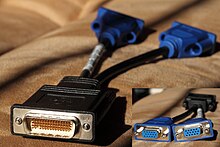Low-force helix
This article has multiple issues. Please help improve it or discuss these issues on the talk page. (Learn how and when to remove these messages)
|
A low-force helix (LFH-60) is a 60-pin electrical connector (four rows of 15 pins) with signals for two digital and analog connectors. Each of the pins is twisted approximately 45 degrees between the tip and the plastic frame which holds the pins in place. Hence "helix" in the name.
The DMS-59 is a derivative of the LFH60.




The LFH connector is typically used with workstations, because it can connect a single computer graphics source to up to four different monitors. The standard interface is a 60-pin LFH connector with two breakout VGA or DVI cables. This system provides users with flexibility for a variety of display configurations, though forsakes standard DVI or VGA connectors. This renders the LFH connector unusable without an adapter.
It's also used in HDCI (High Definition Camera Interface) used in Polycom HDX video conferencing systems.
Using the LFH interface requires a graphics card with multi-monitor capabilities and an LFH port. NVIDIA and Matrox used to manufacture such cards.
Another application of LFH capabilities is manufactured by Matrox. The Matrox card outputs via two LFH cables to a single monitor, delivering 9.2 million pixels of resolution (3840 × 2400). This system provides large amounts of detailed information for professional applications such as aerospace and automotive visualization, computer aided design, desktop publishing, digital photography, life sciences, mapping, oil and gas exploration, plant design and management, satellite imaging, space exploration, and transportation and logistics.
The LFH connector is used in some Cisco routers and WAN Interface Cards.[1]
See also
[edit]- DMS-59
- Molex
- very-high-density cable interconnect standardized as SCSI interface which is often used to carry four digital/analog monitor signals
References
[edit]- ^ "Understanding the 1-Port Serial WAN Interface Card (WIC-1T)". Cisco. Retrieved 2021-03-08.
